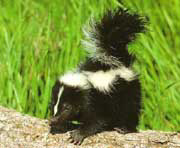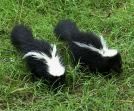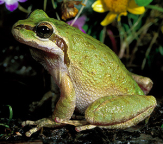Docent Circle: Field Notes Week of 2005-04-04
 The Mediterranean climate of the Central Valley and Coast Ranges
pushes animals and plants into a flurry of spring activity before
the crinkling heat of summer envelops the landscape. Among these is
the gentle California tiger salamander. Only
recently recognized as a separate species, it has generated intense
controversy over the protection of its critically threatened
populations. With the first soaking winter rains, adults lay their
eggs in seasonally ephemeral grassland ponds. Tiger salamander
larvae must metamorphose fast, before their natal pools vaporize in
the summer sun. Leaving the water as two to three inch replicas of
the adults, the juveniles find safety in moist rodent burrows where
they slowly grow in size.
The Mediterranean climate of the Central Valley and Coast Ranges
pushes animals and plants into a flurry of spring activity before
the crinkling heat of summer envelops the landscape. Among these is
the gentle California tiger salamander. Only
recently recognized as a separate species, it has generated intense
controversy over the protection of its critically threatened
populations. With the first soaking winter rains, adults lay their
eggs in seasonally ephemeral grassland ponds. Tiger salamander
larvae must metamorphose fast, before their natal pools vaporize in
the summer sun. Leaving the water as two to three inch replicas of
the adults, the juveniles find safety in moist rodent burrows where
they slowly grow in size.

 Striped Skunks get to show their sweeter sides for a few moments this
month, for this is their mating season. Later in May, four to seven
wrinkled, blind, furless young are born in a hollow log or
underground chamber. Skunks are omnivorous, eating mice, eggs,
insects, grubs, fruit, carrion, and shrews. Great horned owls are
predators that commonly eat skunks. The youngsters may be spotted
following their mother in single file through woodlands and fields
through the summer.
Striped Skunks get to show their sweeter sides for a few moments this
month, for this is their mating season. Later in May, four to seven
wrinkled, blind, furless young are born in a hollow log or
underground chamber. Skunks are omnivorous, eating mice, eggs,
insects, grubs, fruit, carrion, and shrews. Great horned owls are
predators that commonly eat skunks. The youngsters may be spotted
following their mother in single file through woodlands and fields
through the summer.
A single Pacific chorus frog emits a cautious "krek eck" and soon dozens of his
subordinate rivals join in for an evening of mate-attracting song.
Formerly known as tree frogs, Pacific chorus frogs are California's
most wide-spread amphibian, ranging from Mojave Desert oases to
 Sierra peaks. Anytime between January and July when local moisture
and temperature are just right, chorus frogs migrate to creeks,
puddles, ponda and pools to mate. Females spend only a day or two
at these sites, but male frogs hang out for a couple of weeks,
singing to establish their territory -- a circle no larger than a
throw rug -- and to advertise for successive mates. If you live
near a creek, pond, or even a vacant lot full of puddles, open your
window on a moist winter evening and listen for the sometimes
deafening symphonic choirs of these silver dollar-sized
amphibians.
Sierra peaks. Anytime between January and July when local moisture
and temperature are just right, chorus frogs migrate to creeks,
puddles, ponda and pools to mate. Females spend only a day or two
at these sites, but male frogs hang out for a couple of weeks,
singing to establish their territory -- a circle no larger than a
throw rug -- and to advertise for successive mates. If you live
near a creek, pond, or even a vacant lot full of puddles, open your
window on a moist winter evening and listen for the sometimes
deafening symphonic choirs of these silver dollar-sized
amphibians.
 Coyote pairs
breed from January to March. Before their pups are born, the pair
usually prepares several den sites. They prefer south-facing slopes
for dens, digging new holes into the dirt or using abandoned badger
burrows. If a den is disturbed or the pair feels threatened, they
move quickly to one of their reserve sites. After a gestation
period of about two months, a coyote mother produces a litter of
perhaps a half dozen pups, typically with only one managing to
survive into adulthood. The coyote and his mate both
contribute to the support of the litter, although he is not invited
into the den or to the dinner table. When the puppies reach a
couple of months old, the mother, probably having had enough of
coyote babies, teaches her pups to hunt and prepares them for
independence.
Coyote pairs
breed from January to March. Before their pups are born, the pair
usually prepares several den sites. They prefer south-facing slopes
for dens, digging new holes into the dirt or using abandoned badger
burrows. If a den is disturbed or the pair feels threatened, they
move quickly to one of their reserve sites. After a gestation
period of about two months, a coyote mother produces a litter of
perhaps a half dozen pups, typically with only one managing to
survive into adulthood. The coyote and his mate both
contribute to the support of the litter, although he is not invited
into the den or to the dinner table. When the puppies reach a
couple of months old, the mother, probably having had enough of
coyote babies, teaches her pups to hunt and prepares them for
independence.
 Supremely adaptable, adventurous, bold and clever, the coyote
has expanded its range and increased its population across much of
the North American continent. Spindly legged but swift, the coyote
wears a coat that runs silvery gray to brown down the back, creamy
on the belly, and rusty on its spindly legs. It sports a tail
that is black-tipped, much like that of the wolf. A true scavenger
and opportunist, the coyote will, "eat almost anything animal or
vegetable..." It may hunt in relays with a
companion coyote, with the two yipping alternately during a
chase. It follows hunting routes that may range well over 10
miles. It may cache uneaten food. Listen for the
haunting howl or the excited yipping of the coyote in the evening,
in the Laguna.
Supremely adaptable, adventurous, bold and clever, the coyote
has expanded its range and increased its population across much of
the North American continent. Spindly legged but swift, the coyote
wears a coat that runs silvery gray to brown down the back, creamy
on the belly, and rusty on its spindly legs. It sports a tail
that is black-tipped, much like that of the wolf. A true scavenger
and opportunist, the coyote will, "eat almost anything animal or
vegetable..." It may hunt in relays with a
companion coyote, with the two yipping alternately during a
chase. It follows hunting routes that may range well over 10
miles. It may cache uneaten food. Listen for the
haunting howl or the excited yipping of the coyote in the evening,
in the Laguna.
Back to the Field Notes Archive
 The Mediterranean climate of the Central Valley and Coast Ranges
pushes animals and plants into a flurry of spring activity before
the crinkling heat of summer envelops the landscape. Among these is
the gentle California tiger salamander. Only
recently recognized as a separate species, it has generated intense
controversy over the protection of its critically threatened
populations. With the first soaking winter rains, adults lay their
eggs in seasonally ephemeral grassland ponds. Tiger salamander
larvae must metamorphose fast, before their natal pools vaporize in
the summer sun. Leaving the water as two to three inch replicas of
the adults, the juveniles find safety in moist rodent burrows where
they slowly grow in size.
The Mediterranean climate of the Central Valley and Coast Ranges
pushes animals and plants into a flurry of spring activity before
the crinkling heat of summer envelops the landscape. Among these is
the gentle California tiger salamander. Only
recently recognized as a separate species, it has generated intense
controversy over the protection of its critically threatened
populations. With the first soaking winter rains, adults lay their
eggs in seasonally ephemeral grassland ponds. Tiger salamander
larvae must metamorphose fast, before their natal pools vaporize in
the summer sun. Leaving the water as two to three inch replicas of
the adults, the juveniles find safety in moist rodent burrows where
they slowly grow in size. 
 Striped Skunks get to show their sweeter sides for a few moments this
month, for this is their mating season. Later in May, four to seven
wrinkled, blind, furless young are born in a hollow log or
underground chamber. Skunks are omnivorous, eating mice, eggs,
insects, grubs, fruit, carrion, and shrews. Great horned owls are
predators that commonly eat skunks. The youngsters may be spotted
following their mother in single file through woodlands and fields
through the summer.
Striped Skunks get to show their sweeter sides for a few moments this
month, for this is their mating season. Later in May, four to seven
wrinkled, blind, furless young are born in a hollow log or
underground chamber. Skunks are omnivorous, eating mice, eggs,
insects, grubs, fruit, carrion, and shrews. Great horned owls are
predators that commonly eat skunks. The youngsters may be spotted
following their mother in single file through woodlands and fields
through the summer. Sierra peaks. Anytime between January and July when local moisture
and temperature are just right, chorus frogs migrate to creeks,
puddles, ponda and pools to mate. Females spend only a day or two
at these sites, but male frogs hang out for a couple of weeks,
singing to establish their territory -- a circle no larger than a
throw rug -- and to advertise for successive mates. If you live
near a creek, pond, or even a vacant lot full of puddles, open your
window on a moist winter evening and listen for the sometimes
deafening symphonic choirs of these silver dollar-sized
amphibians.
Sierra peaks. Anytime between January and July when local moisture
and temperature are just right, chorus frogs migrate to creeks,
puddles, ponda and pools to mate. Females spend only a day or two
at these sites, but male frogs hang out for a couple of weeks,
singing to establish their territory -- a circle no larger than a
throw rug -- and to advertise for successive mates. If you live
near a creek, pond, or even a vacant lot full of puddles, open your
window on a moist winter evening and listen for the sometimes
deafening symphonic choirs of these silver dollar-sized
amphibians.
 Coyote pairs
breed from January to March. Before their pups are born, the pair
usually prepares several den sites. They prefer south-facing slopes
for dens, digging new holes into the dirt or using abandoned badger
burrows. If a den is disturbed or the pair feels threatened, they
move quickly to one of their reserve sites. After a gestation
period of about two months, a coyote mother produces a litter of
perhaps a half dozen pups, typically with only one managing to
survive into adulthood. The coyote and his mate both
contribute to the support of the litter, although he is not invited
into the den or to the dinner table. When the puppies reach a
couple of months old, the mother, probably having had enough of
coyote babies, teaches her pups to hunt and prepares them for
independence.
Coyote pairs
breed from January to March. Before their pups are born, the pair
usually prepares several den sites. They prefer south-facing slopes
for dens, digging new holes into the dirt or using abandoned badger
burrows. If a den is disturbed or the pair feels threatened, they
move quickly to one of their reserve sites. After a gestation
period of about two months, a coyote mother produces a litter of
perhaps a half dozen pups, typically with only one managing to
survive into adulthood. The coyote and his mate both
contribute to the support of the litter, although he is not invited
into the den or to the dinner table. When the puppies reach a
couple of months old, the mother, probably having had enough of
coyote babies, teaches her pups to hunt and prepares them for
independence. Supremely adaptable, adventurous, bold and clever, the coyote
has expanded its range and increased its population across much of
the North American continent. Spindly legged but swift, the coyote
wears a coat that runs silvery gray to brown down the back, creamy
on the belly, and rusty on its spindly legs. It sports a tail
that is black-tipped, much like that of the wolf. A true scavenger
and opportunist, the coyote will, "eat almost anything animal or
vegetable..." It may hunt in relays with a
companion coyote, with the two yipping alternately during a
chase. It follows hunting routes that may range well over 10
miles. It may cache uneaten food. Listen for the
haunting howl or the excited yipping of the coyote in the evening,
in the Laguna.
Supremely adaptable, adventurous, bold and clever, the coyote
has expanded its range and increased its population across much of
the North American continent. Spindly legged but swift, the coyote
wears a coat that runs silvery gray to brown down the back, creamy
on the belly, and rusty on its spindly legs. It sports a tail
that is black-tipped, much like that of the wolf. A true scavenger
and opportunist, the coyote will, "eat almost anything animal or
vegetable..." It may hunt in relays with a
companion coyote, with the two yipping alternately during a
chase. It follows hunting routes that may range well over 10
miles. It may cache uneaten food. Listen for the
haunting howl or the excited yipping of the coyote in the evening,
in the Laguna.